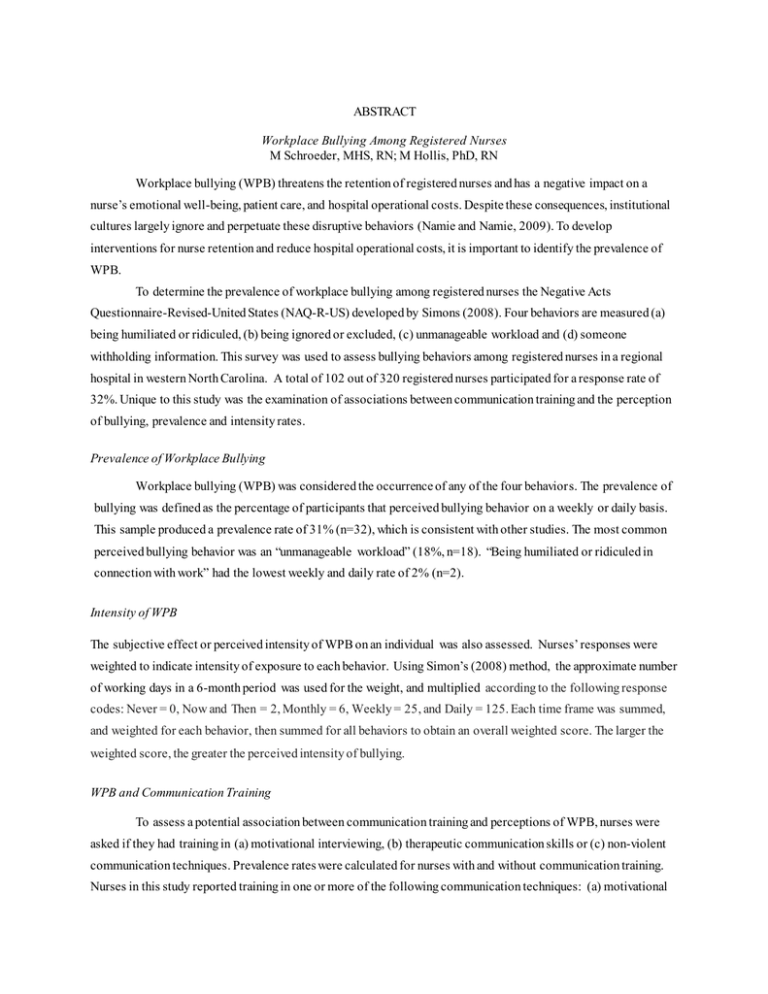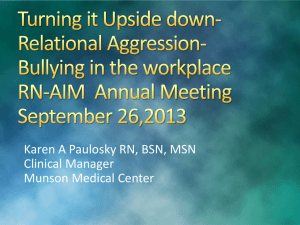ABSTRACT M Schroeder, MHS, RN; M Hollis, PhD, RN
advertisement

ABSTRACT Workplace Bullying Among Registered Nurses M Schroeder, MHS, RN; M Hollis, PhD, RN Workplace bullying (WPB) threatens the retention of registered nurses and has a negative impact on a nurse’s emotional well-being, patient care, and hospital operational costs. Despite these consequences, institutional cultures largely ignore and perpetuate these disruptive behaviors (Namie and Namie, 2009). To develop interventions for nurse retention and reduce hospital operational costs, it is important to identify the prevalence of WPB. To determine the prevalence of workplace bullying among registered nurses the Negative Acts Questionnaire-Revised-United States (NAQ-R-US) developed by Simons (2008). Four behaviors are measured (a) being humiliated or ridiculed, (b) being ignored or excluded, (c) unmanageable workload and (d) someone withholding information. This survey was used to assess bullying behaviors among registered nurses in a regional hospital in western North Carolina. A total of 102 out of 320 registered nurses participated for a response rate of 32%. Unique to this study was the examination of associations between communication training and the perception of bullying, prevalence and intensity rates. Prevalence of Workplace Bullying Workplace bullying (WPB) was considered the occurrence of any of the four behaviors. The prevalence of bullying was defined as the percentage of participants that perceived bullying behavior on a weekly or daily basis. This sample produced a prevalence rate of 31% (n=32), which is consistent with other studies. The most common perceived bullying behavior was an “unmanageable workload” (18%, n=18). “Being humiliated or ridiculed in connection with work” had the lowest weekly and daily rate of 2% (n=2). Intensity of WPB The subjective effect or perceived intensity of WPB on an individual was also assessed. Nurses’ responses were weighted to indicate intensity of exposure to each behavior. Using Simon’s (2008) method, the approximate number of working days in a 6-month period was used for the weight, and multiplied according to the following response codes: Never = 0, Now and Then = 2, Monthly = 6, Weekly = 25, and Daily = 125. Each time frame was summed, and weighted for each behavior, then summed for all behaviors to obtain an overall weighted score. The larger the weighted score, the greater the perceived intensity of bullying. WPB and Communication Training To assess a potential association between communication training and perceptions of WPB, nurses were asked if they had training in (a) motivational interviewing, (b) therapeutic communication skills or (c) non-violent communication techniques. Prevalence rates were calculated for nurses with and without communication training. Nurses in this study reported training in one or more of the following communication techniques: (a) motivational interviewing (MI): 25% (n=25), (b) nonviolent communication (NVC): 69% (n=69) and (c) therapeutic communication (TC): 72% (n=72). A comparison of prevalence rates between nurses reporting communication training and those that did not was performed. Registered nurses who had communication training had a lower prevalence rate of WPB as nurses without training (With training=22% (n=38); without training=38% (n=49). Nurses with communication training also demonstrated significantly lower intensity scores consistent with their lower prevalence rate (RNs with training = 1450; RNs without training =2625). These results suggests that nurses without communication training perceive bullying more frequently and of higher intensity than nurses with some form of therapeutic communication education. Conclusions The 31% prevalence rate for workplace bullying among nurses in this study is consistent with Simons (2008) and Johnson and Rea’s (2009) findings. These authors also examined associations between prevalence of bullying and intent to leave. Johnson and Rea (2009) found bullied nurses were three times more likely to leave a position (X2 =19.1; df =2, p<.001), while Simon’s (2008) study yielded a moderate but significant correlation (r =0.51, p<.001) for bullying and intent to leave. Results from these studies indicate the greater the level of perceived bullying the more likely the intent to leave. The results between communication training and the prevalence and intensity of bullying in this sample suggest nurses with communication skills perceive bullying behaviors less often. Additionally, when such behaviors were perceived by this group, the intensity of the encounters was less severe. This study examined only the presence or absence of communication training and only with registered nurses. Future studies might investigate different types of communication training and the impact of specific skills on perception and intensity of bullying behaviors . Differences in prevalence rates between these two groups also support the provision of communication skills as one method to decrease bullying behavior perceptions. However, approximately one third of all nurses perceived some level of bullying which may affect intent to leave, patient care, and hospital operational costs. Implications Nursing leaders, as advocates for inter-collegial communications, recognize the impact of a less than positive work environment on the recruitment and retention of registered nurses. While bullying behaviors are not tolerated as a matter of professionalism, this study as well as others cited, reveal that opportunities continue to exist to reduce the rate of negative behaviors. Unique to this research was the finding that nurses with some form of therapeutic communication education had a lower rate of perceived bullying and intensity when bullying did occur. These data contribute facility-specific information; useful in developing interventions to improve communication skills, reduce bullying behaviors, reinforce a culture of collegial collaboration and positively impact nurse recruitment and retention.



